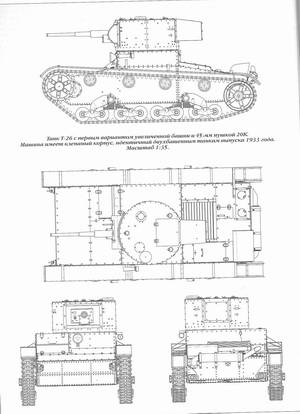 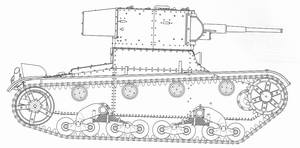 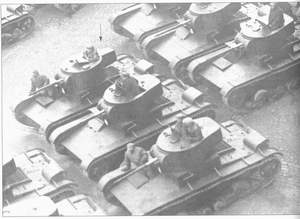 |
T-26 equipped with the first variant of the larger turret and 45mm "20K"-type gun. The vehicle has riveted hull identical to twin-turreted T-26 Mod. 1933 version.
Photo: T-26 first series of the tank on parade in 1933. One tank is equipped with an earlier version turret (with smaller rear section and single hatch.[1]
|
 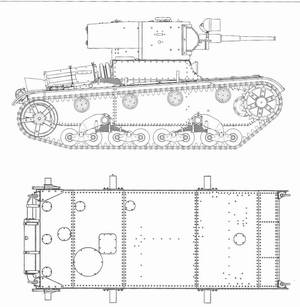  |
Line T-26M34 tank. In cmoparison with earlier vehicles years 1931-33 production this one has riveted hull, hatch to transmission compartment (in upper frontal plate) and battle searchlights.[1]
Photo: T-26M34 tanks on parade. Probably Khabarovsk, Nov. 7 1935. [1]
|
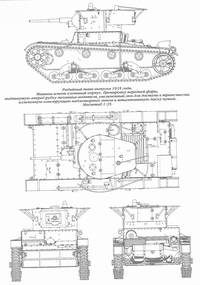 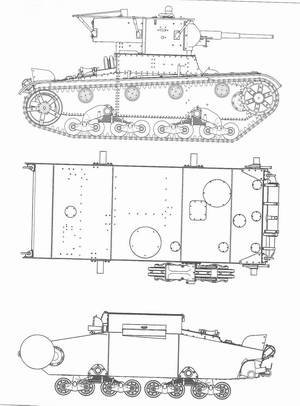 ![Photo: T-26M35 tank equipped with radio station at Kiev's manoeuvres, 1935 [1]](T-26/2/T_26M35RT_1cut.jpg) |
T-26M35 equipped with radio transmitter. The vehicle has riveted hull, armoured headlight, driver's cabin moved forward, enlarged hatch to transmission compartement, modified hatches above engine and punched gun mask. [1]
Photo: T-26M35 tank equipped with radio transmitter during the Kiev manoeuvres in 1935 [1]
|
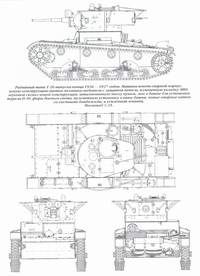  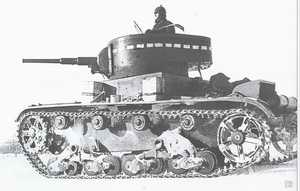 |
T-26 tank of late 1936-1937 years production equipped with radio transmitter. The tank has new design of a tank-driver's dashboard with additional pivot hinge's protection, changed packing of tools and spares, new horn, punched gun mask, a hatch in the turret for P-40 machine-gun ring, combat searchlights, machine-gun mounted in a rear side, new rollers with removable rims and strengthened idler.[1]
Photo: T-26 year 1936 production series at the manoeuvres of Moscow Military District. The tank has welded hull and punched gun mask. [1] |
![The general view of T-26M35 tank (produced in 1936) equipped with radio station with welded hull and turret. [1]](T-26/2/T_26M35RT_3a_cut.jpg) ![The general view of T-26M35 tank (produced in 1936) equipped with radio station with welded hull and turret. [1]](T-26/2/T_26M35RT_3b_cut.jpg) ![The general view of T-26M35 tank (produced in 1936) equipped with radio station with welded hull and turret. [1]](T-26/2/T_26M35RT_3c_cut.jpg) ![The general view of T-26M35 tank (produced in 1936) equipped with radio station with welded hull and turret. [1]](T-26/2/T_26M35RT_3d_cut.jpg) |
The general view of T-26M35 tank (produced in 1936) equipped with radio transmitter and welded hull & turret. [1]
|
 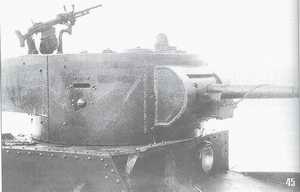 |
T-26 with pivot anti-aircraft machine-gun. S.M. Kirov plant No. 185, 1936 [1]
|
 |
Late T-26M33 with cylindrical turret at the Central Museum of Russian Army. Moscow. [AMVAS's photo] |
 |
Finnish "modernization" of T-26: the turret from a line tank, mounted on the hull of OT-26 on the right. Karelia, 1943 [1] |
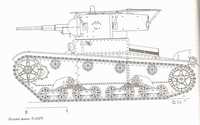 |
Blueprint of T-26 with cylindrical turret. [2] |
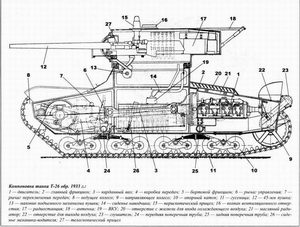
|
T-26M33 composition [5] |
- Engine;
- Main friction clutch;
- Driveshaft;
- Transmission;
- Side clutch;
- Сontrol lever;
- Gear shift lever;
- Driving-wheel;
- Guide wheel;
- Supporting roller;
- Track;
- 45mm gun;
- Gun elevating hand wheel;
- Gunlayer seat;
|
- Periscope sight;
- Ventipane's cap;
- Radio transmitter position;
- Antenna;
- VKU (Internal communication device(?));
- Air inlet louvres;
- Oil radiator;
- Air outlet;
- Muffler;
- Frontal transverse tube;
- Rear transverse tube;
- Tank driver seat;
- Telescope sight.
|
 |
T-26 with cylindrical turret armor plating schematic diagramme [2] |
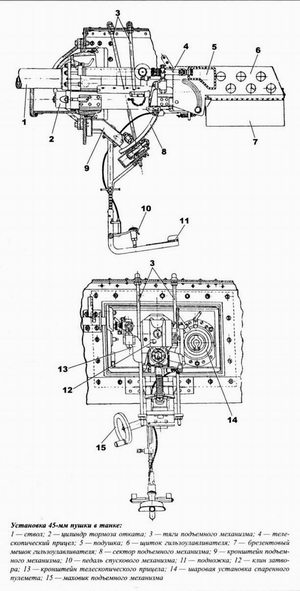 |
45mm gun mounting [5]
- Barrel;
- Recoil brake cylinder;
- Elevating mechanism operating rod;
- Telescopic sight;
- Cushion;
- Shell catcher shield;
- Canvas shell catcher bag;
- Sector of gun elevating mechanism;
- Bracket of elevating mechanism;
- Trigger pedal;
- Footboard;
- Breech locking mechanism;
- Telescopic sight bracket;
- Machine-gun spherical device;
- Elevating mechanism hand wheel.
|
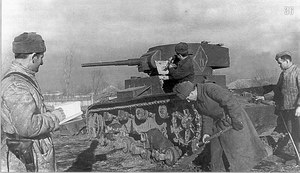 |
Repair to a T-26 (1933 series) assigned to 24th Separate Tank Regiment. The Crimean Front, April 1942.[3] |
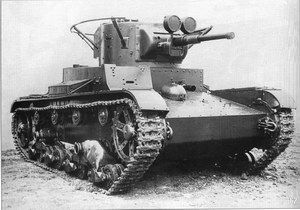 |
T-26 tank (1933 version with cylindrical turret) was the most universally used tank in the Red Army before the war. The unit in the photo shows a unit equipped with radio transmitter, handrail style antenna and search lights for night firing.[4] |
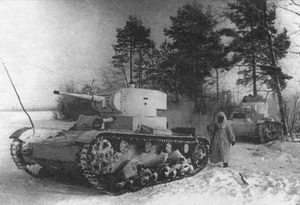 |
T-26 assigned to the 35th Light Tank Brigade moving into an attack line, Feb., 1940[5] |
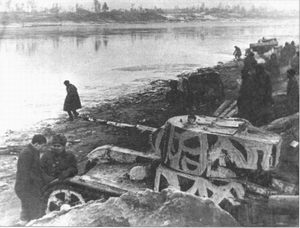 |
T-26 in winter camouflage. Nevskaya Dubrovka, Leningrad Front, 1942 [5] |
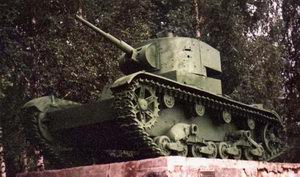 |
T-26M33 on display as a monument in Korovitino village (Novgorod region). Note the non-original tracks [5] |
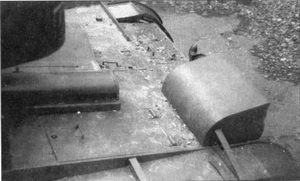 |
Top view of the engine compartment. Cover over the air outlet was introduced immediately after the start of initial production. The concave cover to the air intake was introduced after the Spanish campaign following experience of "Molotov cocktails" being used against the tanks.[5] |
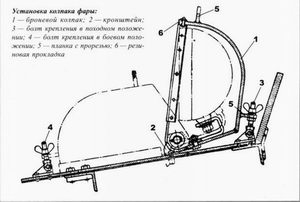 |
Headlight cap installation [5]
- Armored cap;
- Bracket;
- Fixing bolt (stowed position);
- Fixing bolt (combat position);
- Slotted bracket;
- Rubber gasket
|
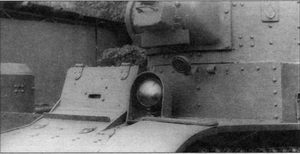 |
Front view. Installation of headlight in movable cover was typical of the last production series. Horn can be seen to the right of the headlight.[5] |